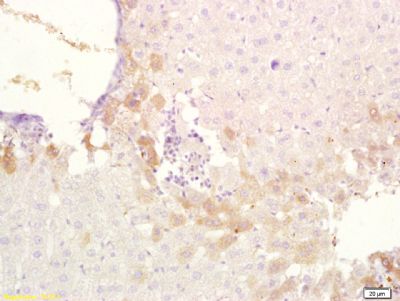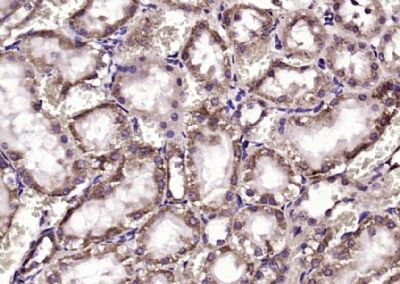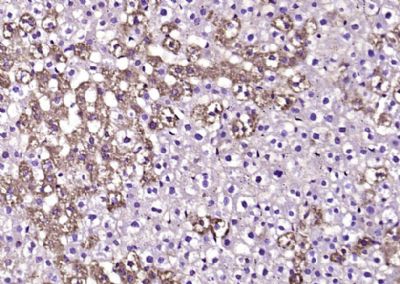ABCB6 Polyclonal Antibody
Purified Rabbit Polyclonal Antibody (Pab)
- SPECIFICATION
- CITATIONS
- PROTOCOLS
- BACKGROUND

Application
| IHC-P, IHC-F, IF, E |
|---|---|
| Primary Accession | Q9NP58 |
| Reactivity | Rat, Pig, Dog, Bovine |
| Host | Rabbit |
| Clonality | Polyclonal |
| Calculated MW | 94 KDa |
| Physical State | Liquid |
| Immunogen | KLH conjugated synthetic peptide derived from human ABCB6 |
| Epitope Specificity | 401-520/842 |
| Isotype | IgG |
| Purity | affinity purified by Protein A |
| Buffer | 0.01M TBS (pH7.4) with 1% BSA, 0.02% Proclin300 and 50% Glycerol. |
| SUBCELLULAR LOCATION | Cell membrane. Mitochondrion outer membrane; Multi-pass membrane protein. Endoplasmic reticulum. Golgi apparatus. |
| SIMILARITY | Belongs to the ABC transporter superfamily. ABCB family. Heavy Metal importer (TC 3.A.1.210) subfamily.Contains 1 ABC transmembrane type-1 domain.Contains 1 ABC transporter domain. |
| SUBUNIT | Homodimer. |
| DISEASE | Microphthalmia, isolated, with coloboma, 7 (MCOPCB7) [MIM:614497]: A disorder of eye formation, ranging from small size of a single eye to complete bilateral absence of ocular tissues. Ocular abnormalities like opacities of the cornea and lens, scaring of the retina and choroid, cataract and other abnormalities like cataract may also be present. Ocular colobomas are a set of malformations resulting from abnormal morphogenesis of the optic cup and stalk, and the fusion of the fetal fissure (optic fissure). Note=The disease is caused by mutations affecting the gene represented in this entry. |
| Important Note | This product as supplied is intended for research use only, not for use in human, therapeutic or diagnostic applications. |
| Background Descriptions | The membrane-associated protein encoded by this gene is a member of the superfamily of ATP-binding cassette (ABC) transporters. ABC proteins transport various molecules across extra- and intra-cellular membranes. ABC genes are divided into seven distinct subfamilies (ABC1, MDR/TAP, MRP, ALD, OABP, GCN20, White). This protein is a member of the MDR/TAP subfamily. Members of the MDR/TAP subfamily are involved in multidrug resistance as well as antigen presentation. This half-transporter likely plays a role in mitochondrial function. Localized to 2q26, this gene is considered a candidate gene for lethal neonatal metabolic syndrome, a disorder of mitochondrial function. |
| Gene ID | 10058 |
|---|---|
| Other Names | ATP-binding cassette sub-family B member 6, mitochondrial, Mitochondrial ABC transporter 3, Mt-ABC transporter 3, P-glycoprotein-related protein, Ubiquitously-expressed mammalian ABC half transporter, ABCB6, MTABC3, PRP, UMAT |
| Target/Specificity | Widely expressed. High expression is detected in the retinal epithelium. |
| Dilution | IHC-P=1:100-500,IHC-F=1:100-500,IF=1:100-500,ELISA=1:5000-10000 |
| Storage | Store at -20 ℃ for one year. Avoid repeated freeze/thaw cycles. When reconstituted in sterile pH 7.4 0.01M PBS or diluent of antibody the antibody is stable for at least two weeks at 2-4 ℃. |
| Name | ABCB6 (HGNC:47) |
|---|---|
| Function | ATP-dependent transporter that catalyzes the transport of a broad-spectrum of porphyrins from the cytoplasm to the extracellular space through the plasma membrane or into the vesicle lumen (PubMed:17661442, PubMed:23792964, PubMed:27507172, PubMed:33007128). May also function as an ATP-dependent importer of porphyrins from the cytoplasm into the mitochondria, in turn may participate in the de novo heme biosynthesis regulation and in the coordination of heme and iron homeostasis during phenylhydrazine stress (PubMed:10837493, PubMed:17006453, PubMed:23792964, PubMed:33007128). May also play a key role in the early steps of melanogenesis producing PMEL amyloid fibrils (PubMed:29940187). In vitro, it confers to cells a resistance to toxic metal such as arsenic and cadmium and against chemotherapeutics agent such as 5-fluorouracil, SN-38 and vincristin (PubMed:21266531, PubMed:25202056, PubMed:31053883). In addition may play a role in the transition metal homeostasis (By similarity). |
| Cellular Location | Cell membrane; Multi-pass membrane protein. Mitochondrion outer membrane; Multi-pass membrane protein. Endoplasmic reticulum membrane; Multi-pass membrane protein. Golgi apparatus membrane; Multi-pass membrane protein. Endosome membrane; Multi-pass membrane protein. Lysosome membrane. Late endosome membrane {ECO:0000250|UniProtKB:O70595}. Early endosome membrane {ECO:0000250|UniProtKB:O70595}. Secreted, extracellular exosome. Mitochondrion. Endosome, multivesicular body membrane. Melanosome membrane. Note=Present in the membrane of mature erythrocytes and in exosomes released from reticulocytes during the final steps of erythroid maturation (PubMed:22655043). Traffics from endoplasmic reticulum to Golgi during its glycans's maturation, therefrom is first targeted to the plasma membrane, and is rapidly internalized through endocytosis to be distributed to the limiting membrane of multivesicular bodies and lysosomes (PubMed:18279659, PubMed:21199866, PubMed:25627919). Localized on the limiting membrane of early melanosomes of pigment cells (PubMed:29940187). Targeted to the endolysosomal compartment (By similarity) {ECO:0000250|UniProtKB:O70595, ECO:0000269|PubMed:18279659, ECO:0000269|PubMed:21199866, ECO:0000269|PubMed:22655043, ECO:0000269|PubMed:25627919, ECO:0000269|PubMed:29940187} |
| Tissue Location | Widely expressed. High expression is detected in the retinal epithelium (PubMed:10837493, PubMed:22226084). Expressed in mature erythrocytes (PubMed:22655043). |

Thousands of laboratories across the world have published research that depended on the performance of antibodies from Abcepta to advance their research. Check out links to articles that cite our products in major peer-reviewed journals, organized by research category.
info@abcepta.com, and receive a free "I Love Antibodies" mug.
Provided below are standard protocols that you may find useful for product applications.
If you have used an Abcepta product and would like to share how it has performed, please click on the "Submit Review" button and provide the requested information. Our staff will examine and post your review and contact you if needed.
If you have any additional inquiries please email technical services at tech@abcepta.com.













 Foundational characteristics of cancer include proliferation, angiogenesis, migration, evasion of apoptosis, and cellular immortality. Find key markers for these cellular processes and antibodies to detect them.
Foundational characteristics of cancer include proliferation, angiogenesis, migration, evasion of apoptosis, and cellular immortality. Find key markers for these cellular processes and antibodies to detect them. The SUMOplot™ Analysis Program predicts and scores sumoylation sites in your protein. SUMOylation is a post-translational modification involved in various cellular processes, such as nuclear-cytosolic transport, transcriptional regulation, apoptosis, protein stability, response to stress, and progression through the cell cycle.
The SUMOplot™ Analysis Program predicts and scores sumoylation sites in your protein. SUMOylation is a post-translational modification involved in various cellular processes, such as nuclear-cytosolic transport, transcriptional regulation, apoptosis, protein stability, response to stress, and progression through the cell cycle. The Autophagy Receptor Motif Plotter predicts and scores autophagy receptor binding sites in your protein. Identifying proteins connected to this pathway is critical to understanding the role of autophagy in physiological as well as pathological processes such as development, differentiation, neurodegenerative diseases, stress, infection, and cancer.
The Autophagy Receptor Motif Plotter predicts and scores autophagy receptor binding sites in your protein. Identifying proteins connected to this pathway is critical to understanding the role of autophagy in physiological as well as pathological processes such as development, differentiation, neurodegenerative diseases, stress, infection, and cancer.




